Fungiacyathidae
Fungiacyathus
Stephen D. Cairns- Fungiacyathus (Fungiacyathus)
- Fungiacyathus (Bathyactis)
Introduction
The fungiacyathids are known from the Late Cretaceous (Campanian of the Antarctic Peninsula, about 84 million years ago; see Filkorn, 1994) to the Recent. Species are found living in all ocean basins, including off continental Antarctica, and at depths of 70-6328 m, which is the greatest depth from which scleractinian corals have ever been recorded (Keler, 1976). The deepest record, from the Kuril-Kamchatcka Trench, equates to 20,762 feet, or 3.93 miles. The deeper-living species occur below the calcium carbonate compensation depth.
Fungiacyathids are exclusively azooxanthellate and exclusively solitary in growth form, always unattached, laying free on soft substrates. The largest known specimen is 62 mm in calicular diameter (Cairns and Zibrowius, 1997), but most are less than 25 mm in diameter. Their corallum is usually extremely fragile and therefore often damaged in collection. Twenty Recent species are known (Cairns et al., 1999): 6 in the nominate subgenus and 14 in Fungiacyathus (Bathyactis). Six to eight fossil species have also been described (see Filkorn, 1994). Three of the 20 species appear to reproduce primarily by fragmentation and subsequent regeneration. Several species are hosts for the galls of parasitic ascothoracidan Crustacea (Grygier and Zibrowius, 1985).
Characteristics
Solitary, free, discoidal coralla, usually with a flat or slightly concave base (septotheca) that bears ridged costae or granules. Septa highly dentate to laciniate, laterally ridged, and joined to adjacent septa by robust synapticulae. Columella spongy.

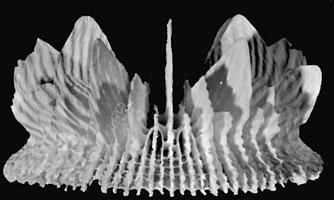
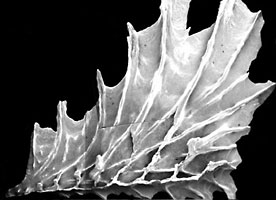
Left: Fungiacyathus stephanus: Side view of a skeleton that was collected from Indonesia (depth 798 m). Diameter of corallum 37 mm (from Cairns, 1989). Right: F. marenzelleri: Side view of an isolated septum, showing trabecular ridges and synapticulae on the septal face. Specimen collected from off California (depth 4100 m). Length of septum 10 mm (from Cairns, 1994).
Discussion of Phylogenetic Relationships
No phylogenetic analysis has been made of the fungiacyathid species.
The subgenera are defined on the basis of septal number: the nominate subgenus has 5 cycles (96 septa) and Fungiacyathus (Bathyactis) has 4 cycles (48 septa); however, Zibrowius (in Cairns and Zibrowius, 1997) suggested that the subgenera be reconstituted based on the nature of the septal edges, i.e., straight or sinuous.
References
Cairns, S. D. 1989. A revision of the ahermatypic Scleractinia of the Philippine Islands and adjacent waters, Part 1: Fungiacyathidae, Micrabaciidae, Turbinoliinae, Guyniidae, and Flabellidae. Smithsonian Contributions to Zoology, 486: 136 pp.
Cairns, S. D. 1994. Scleractinia of the temperate North Pacific. Smithsonian Contributions to Zoology, 557: 150 pp.
Cairns, S. D. 1995. The marine fauna of New Zealand: Scleractinia (Cnidaria: Anthozoa). New Zealand Oceanographic Institute Memoirs, 103: 210 pp.
Cairns, S. D. and H. Zibrowius. 1997. Cnidaria, Anthozoa: Azooxanthellate Scleractinia from the Philippine and Indonesian regions. Mémoires du Muséum National d'Histoire Naturelle, 172: 27-243.
Cairns, S. D., B. W. Hoeksema, and J. van der Land. 1999. Appendix: List of Extant Stony Corals. Attol Research Bulletin, 459:13-46.
Chevalier, J.-P. 1987. Ordre des Scléractiniares: Systematique. Pp. 679-753 In: Grassé (editor) Traité de Zoologie, 3(3) Masson, Paris.
Filkorn, H. F. 1994. Fossil scleractinian corals from James Ross Basin, Antarctica. Antarctic Research Series, 65: 96 pp.
Grygier, M. J. and H. Zibrowius. 1985. Diversity and range of scleractinian coral hosts of Ascothoracida (Crustacea: Maxillopoda). Annals de l'Institut Océanographique, Paris, 61(2): 115-138.
Keller, N. B. 1976. The deep-sea madreporarian corals of the genus Fungiacyathus from the Kuril-Kamchatka, Aleutian trenches and other regions of world ocean. Trudy Instituta Okeanologii, 99: 31-44 (in Russian).
Wells, J. W. 1956. Scleractinia. Pp. F328-F444 In: Moore, R. C. (editor) Treatise on Invertebrate Paleontology, Part F: Coelenterata. University of Kansas Press, Lawrence.
Title Illustrations

| Scientific Name | Fungiacyathus marenzelleri |
|---|---|
| Location | off northwestern New Zealand (depth 2431 m) |
| Reference | Cairns, S. D. 1995. The marine fauna of New Zealand: Scleractinia (Cnidaria: Anthozoa). New Zealand Oceanographic Institute Memoirs, 103: 210 pp. |
| Specimen Condition | Fossil |
| Body Part | skeleton |
| View | Calicular view |
| Size | Diameter of corallum 35 mm |
| Copyright | © 1995 National Institute of Water & Atmospheric Research |
| Scientific Name | Fungiacyathus stephanus |
|---|---|
| Location | Indonesia (depth 798 m) |
| Reference | Cairns, S. D. 1989. A revision of the ahermatypic Scleractinia of the Philippine Islands and adjacent waters, Part 1: Fungiacyathidae, Micrabaciidae, Turbinoliinae, Guyniidae, and Flabellidae. Smithsonian Contributions to Zoology, 486: 136 pp. |
| Specimen Condition | Fossil |
| Body Part | skeleton |
| View | Oblique view |
| Size | Diameter of corallum 37 mm |
| Image Use |
 This media file is licensed under the Creative Commons Attribution-NonCommercial License - Version 3.0. This media file is licensed under the Creative Commons Attribution-NonCommercial License - Version 3.0.
|
| Copyright |
©

|
About This Page
Creation of this page was supported by US National Science Foundation grants DEB95-21819 and DEB 99-78106 (in the program PEET - Partnerships to Enhance Expertise in Taxonomy) to Daphne G. Fautin, grant DEB99-78086 (in the program PEET) to Stephen D. Cairns, and grant OCE 00-03970 (in NOPP, the National Oceanographic Partnership Program) to D.G.F. and Robert W. Buddemeier.
Technical assistance was rendered by Adorian Ardelean.
The author welcomes the opportunity to identify specimens from this family, and offers to incorporate them into the collection of the National Museum of Natural History, Smithsonian, unless their return is requested.

Smithsonian Institution, Washington, D. C., USA
Correspondence regarding this page should be directed to Stephen D. Cairns at
Page copyright © 2002
 Page: Tree of Life
Fungiacyathidae . Fungiacyathus .
Authored by
Stephen D. Cairns.
The TEXT of this page is licensed under the
Creative Commons Attribution-NonCommercial License - Version 3.0. Note that images and other media
featured on this page are each governed by their own license, and they may or may not be available
for reuse. Click on an image or a media link to access the media data window, which provides the
relevant licensing information. For the general terms and conditions of ToL material reuse and
redistribution, please see the Tree of Life Copyright
Policies.
Page: Tree of Life
Fungiacyathidae . Fungiacyathus .
Authored by
Stephen D. Cairns.
The TEXT of this page is licensed under the
Creative Commons Attribution-NonCommercial License - Version 3.0. Note that images and other media
featured on this page are each governed by their own license, and they may or may not be available
for reuse. Click on an image or a media link to access the media data window, which provides the
relevant licensing information. For the general terms and conditions of ToL material reuse and
redistribution, please see the Tree of Life Copyright
Policies.
- First online 28 October 2002
Citing this page:
Cairns, Stephen D. 2002. Fungiacyathidae . Fungiacyathus . Version 28 October 2002. http://tolweb.org/Fungiacyathus/19117/2002.10.28 in The Tree of Life Web Project, http://tolweb.org/





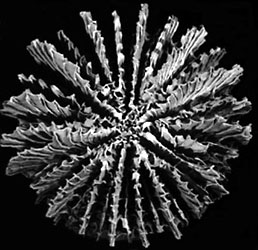
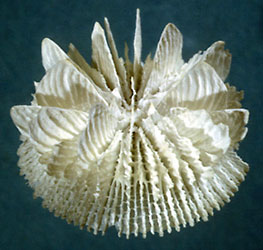
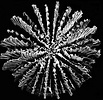



 Go to quick links
Go to quick search
Go to navigation for this section of the ToL site
Go to detailed links for the ToL site
Go to quick links
Go to quick search
Go to navigation for this section of the ToL site
Go to detailed links for the ToL site